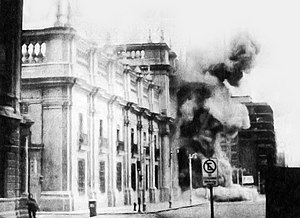Chilean coup, 1973
| 1973 Chilean coup d'état | |||||||||
|---|---|---|---|---|---|---|---|---|---|
| Part of Operation Condor, the history of Chile and the Cold War | |||||||||
 The bombing of La Moneda on 11 September 1973 by the Junta's Armed Forces |
|||||||||
|
|||||||||
| Belligerents | |||||||||
|
"Group of Personal Friends" Other working-class militants |
|||||||||
|
Supported by: |
Supported by: |
||||||||
| Commanders and leaders | |||||||||
|
|
|
||||||||
| Casualties and losses | |||||||||
| 46 GAP | |||||||||
| 60 in total during the coup | |||||||||
The 1973 Chilean coup d'état was a watershed event in both the history of Chile and the Cold War. Following an extended period of social unrest and political tension between the opposition-controlled Congress of Chile and the socialist President Salvador Allende, as well as economic warfare ordered by U.S. President Richard Nixon, Allende was overthrown by the armed forces and national police.
The military deposed Allende's Popular Unity government and later established a junta that suspended all political activity in Chile and repressed left-wing movements, especially the communist and socialist parties and the Revolutionary Left Movement (MIR). Allende's appointed army chief, Augusto Pinochet, rose to supreme power within a year of the coup, formally assuming power in late 1974. The United States government, which had worked to create the conditions for the coup, promptly recognized the junta government and supported it in consolidating power.
During the air raids and ground attacks that preceded the coup, Allende gave his last speech, in which he vowed to stay in the presidential palace, refusing offers of safe passage should he choose exile over confrontation. Direct witness accounts of Allende's death agree that he killed himself in the palace.
...
Wikipedia
